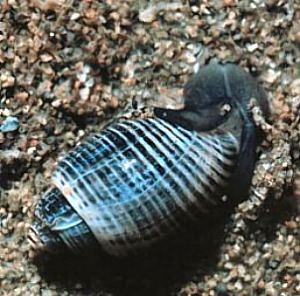
Japonacteon nipponensis
(Yamakawa, 1911)
Order: CEPHALASPIDEA
Superfamily: ACTEONOIDEA
Family: Acteonidae
DISTRIBUTION
Sea of Japan.
PHOTO
Japan Sea, Peter the Great Bay, Ussuri Bay, Sukhodol Bay. September 27 1993. Depth 0,5 - 1 m. Sand. Collected by A.V. Martynov and A.V.Chernyshev. Photo A.V.Martynov.
See Alexander Martynov's message below.
See Japonacteon suturalis Page for messages discussing the characters of the genus.
Reference:
• Taki I., (1956) Japonacteon, a new genus of Pupidae (Opisthobranchia, Gastropoda). Bulletin of the National Science Museum, Tokyo, 3(1): 47-51
Rudman, W.B., 2001 (June 14) Japonacteon nipponensis (Yamakawa, 1911). [In] Sea Slug Forum. Australian Museum, Sydney. Available from http://www.seaslugforum.net/find/japonipp
Related messages
Japonacteon nipponensis from Russia
June 16, 2001
From: Alexander Martynov

Dear Bill,
Great thanks for your information on Japonacteon suturalis. I have enjoyed your comments and the excellent additional pictures of shells and the drawing of the radula. Your exemplars are very similar to those pictured in the Reeve! Recent photos in Forum suggest to me that Japonacteon suturalis is sufficiently distinguished from the type species, J. nipponensis by the colour pattern of the shell and the form of spiral grooves: J. suturalis has a greatly mottled shell and only strong spiral grooves without thin ones. Also it has deeper sutures of whorls. It is likely, that J. suturalis is a strictly tropical species.
Japonacteon suturalis (Adams, 1854) comb. nova by Rudman, 1998 - seems it's a precedent for nomenclature's changes in opisthobranch name directly on the web?
Here is photo of living J. nipponensis from Peter the Great Bay. Specimens are found only in one big bay which is well insolated in summer - Sukhodol, and no other places in all the Russian part of the Japan Sea, where this beautiful species occurs. In Sukhodol Bay also occurs such subtropical elements as the bivalves Dosinia penicillata and Solen corneus, but unlike J. nipponensis they also occur in some other parts of Peter the Great Bay. It looks like Sukhodol Bay is a refuge for this species within the NW part of the Japan Sea.
Photo: Japan Sea, Peter the Great Bay, Ussuri Bay, Sukhodol Bay. September 27 1993. Depth 0,5 - 1 m. Sand. Collected by A.V. Martynov and A.V.Chernyshev. Photo A.V.Martynov.
All the best,
Alexander
martyn@AM3963.spb.edu
Martynov, A., 2001 (Jun 16) Japonacteon nipponensis from Russia. [Message in] Sea Slug Forum. Australian Museum, Sydney. Available from http://www.seaslugforum.net/find/4607Dear Alexander,
Glad to be of help. What an interesting story about this animal looking for a warm sunny bay - almost human!
Thanks very much for the photo. I never expected it to have a black animal. Most shelled opisthobranchs I know of are a translucent white in colour. Would it be too outlandish to suggest that the black animal and blackish shell help the animal to absorb any heat more efficiently?
Best wishes,
Bill Rudman
